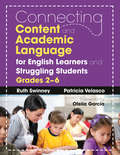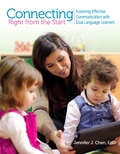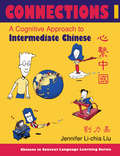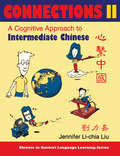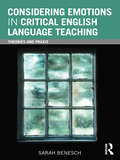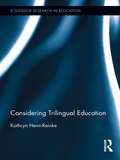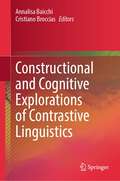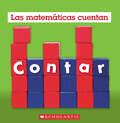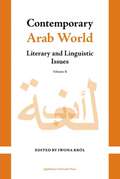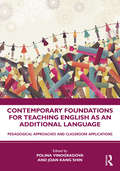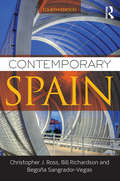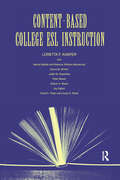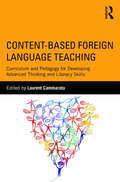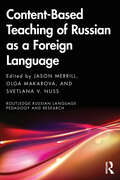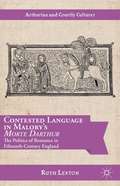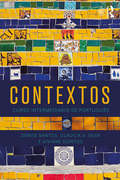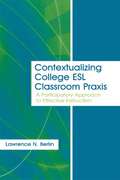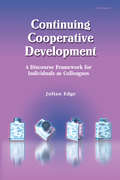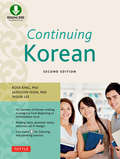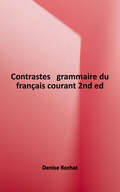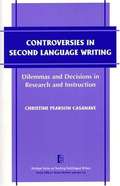- Table View
- List View
Connecting Content and Academic Language for English Learners and Struggling Students, Grades 2–6
by Ruth Swinney Patricia VelascoCreate unit plans that will empower your EL students Award-winning teacher Ruth Swinney and Harvard graduate Patricia Velasco focus on the careful planning needed to develop the academic language of all students. For English learners especially, it is critically important to integrate language development with content. What makes this book unlike any other is the detailed guidance it provides in: Encouraging verbal expression in the classroom Planning units that link language with content Using shared reading and writing, read alouds, and conversation
Connecting Right From the Start: Fostering Effective Communication with Dual Language Learners
by Karen Nemeth Jennifer J. ChenConnecting with dual language learners (DLLs) is a growing reality among early childhood educators, who need to learn practical, proven strategies to reach these students. Grounded in research and strengthened by the author's personal experience as a student learning English, Connecting Right from the Start helps teachers understand the culturally and linguistically diverse children in their classroom, as well as those with disabilities.
Connections I [text + workbook], Textbook & Workbook: A Cognitive Approach to Intermediate Chinese
by Jennifer Li-chia LiuPraise for Interactions I & II:"Practical and lively without neglecting the structure and the writing system. The workbook is especially interesting and helpful." —Chauncey C. Chu, University of Florida". . . by far the best first-year textbooks available." —Sabina Knight, Smith College Connections I & II is the second-year sequence to accompany the enormously popular introductory texts Interactions I & II by Margaret Yan and Jennifer Li-chia Liu. This innovative system makes learning Chinese an interactive, cognitive process rather than a matter of simple rote or drill. Connections is designed to offer intermediate learners of Chinese a complete set of learning tools to improve their language skills and enhance their understanding of Chinese culture and society. Lesson topics revolve around everyday themes and real-world communication among four central characters—a mainland Chinese, a Taiwanese, a Chinese American, and a non-Chinese American—familiar to students using Interactions. Each 10-chapter volume is accompanied by a workbook. Chapters include sections on vocabulary, text, mini-dialogue, characters, grammar, and culture notes, accompanied by engaging graphics. Connections also includes stories and songs, and makes use of a wide variety of texts such as narrative, dialogue, journal entries, riddles, jokes, news headlines, and lyrics.
Connections II [text + workbook], Textbook & Workbook: A Cognitive Approach to Intermediate Chinese
by Jennifer Li-chia LiuPraise for Interactions I & II:"Practical and lively without neglecting the structure and the writing system. The workbook is especially interesting and helpful." —Chauncey C. Chu, University of Florida". . . by far the best first-year textbooks available." —Sabina Knight, Smith College Connections I & II is the second-year sequence to accompany the enormously popular introductory texts Interactions I & II by Margaret Yan and Jennifer Li-chia Liu. This innovative system makes learning Chinese an interactive, cognitive process rather than a matter of simple rote or drill. Connections is designed to offer intermediate learners of Chinese a complete set of learning tools to improve their language skills and enhance their understanding of Chinese culture and society. Lesson topics revolve around everyday themes and real-world communication among four central characters—a mainland Chinese, a Taiwanese, a Chinese American, and a non-Chinese American—familiar to students using Interactions. Each 10-chapter volume is accompanied by a workbook. Chapters include sections on vocabulary, text, mini-dialogue, characters, grammar, and culture notes, accompanied by engaging graphics. Connections also includes stories and songs, and makes use of a wide variety of texts such as narrative, dialogue, journal entries, riddles, jokes, news headlines, and lyrics.
Considering Emotions in Critical English Language Teaching: Theories and Praxis
by Sarah BeneschGroundbreaking in the ways it makes new connections among emotion, critical theory, and pedagogy, this book explores the role of students’ and teachers’ emotions in college instruction, illuminating key literacy and identity issues faced by immigrant students learning English in postsecondary institutions. Offering a rich blend of, and interplay between, theory and practice, it asks: How have emotions and affect been theorized from a critical perspective, and how might these theories be applied to English language teaching and learning? What do complex and shifting emotions, such as hope, disappointment, indignation, and compassion, have to do with English language teaching and learning in the neoliberal context in public universities? How might attention to emotions lead to deeper understanding of classroom interactions and more satisfying educational experiences for English language teachers and students? These questions are addressed not just theoretically, but also practically with examples from college classes of assigned readings, student writing, and classroom talk in which various emotions came into play. Thought-provoking, accessible, and useful, this is a must-read book for scholars, students, and teachers in the field of English language teaching.
Considering Trilingual Education (Routledge Research in Education)
by Kathryn Henn-ReinkeBased in case studies conducted in the US, Europe, and Latin America, this book explores the feasibility and benefits of trilingual/ multilingual education in the United States. Currently, there are few programs in the country of this nature, as educators tend to conclude that English-language learners would be overwhelmed by study in additional languages. Henn-Reinke builds an argument supporting trilingual education in the US, discussing issues of identity, curriculum, pedagogy, and the impact of other psycho-socio-linguistic factors.
Constructional and Cognitive Explorations of Contrastive Linguistics
by Annalisa Baicchi Cristiano BrocciasThis book approaches the field of contrastive linguistics from a comparative and robust perspective that combines the tenets of construction grammar and cognitive linguistics. In doing so, it shows how their integration can help to successfully enhance research on contrastivity, by means of updated theoretical frameworks and applied methodologies that combine language and thought. It compares ten different languages and offers analyses of constructions at all levels of the linguistic organization, identifying the cognitive motivations that instantiate the linguistic data retrieved from corpora. Relevant to both cognitive and non-cognitive linguists interested in variation and contrastive approaches, as well as graduate students in these areas, this book makes a significant contribution to existing work on the various types of constructional and discourse-based phenomena in modern languages.
Contact Languages
by Umberto AnsaldoWhy do groups of speakers in certain times and places come up with new varieties of languages? What are the social settings that determine whether a mixed language, a pidgin or a Creole will develop, and how can we understand the ways in which different languages contribute to the new grammar? Through the study of Malay contact varieties such as Baba Malay, Cocos Malay and Sri Lanka Malay, as well as the Asian Portuguese vernacular of Macau, and China Coast Pidgin, the book explores the social and structural dynamics that underlie the fascinating phenomenon of the creation of new, or restructured, grammars. It emphasizes the importance and interplay of historical documentation, socio-cultural observation and linguistic analysis in the study of contact languages, offering an evolutionary framework for the study of contact language formation - including pidgins and Creoles - in which historical, socio-cultural and typological observations come together.
Contar (Math Counts)
by Henry PluckroseUna serie de libros para introducir a los lectores jovenes a conceptos matematicos fundamentales, ¡ahora en espanol!¿A que numero llegas cuando cuentas todos los dedos de una mano? ¿Alguna vez has contado cuantos pasos haces mientras subes y bajas unas escaleras? Contar nos ayuda a saber "¿cuantos?" Con ejemplos del mundo real, fotografias convincentes y textos inspiradores, ¡esta es la introduccion perfecta al concepto matematico de "contar" para los lectores mas jovenes!Sobre la serie:Publicada originalmente en los anos 90 y actualizada recientemente, esta revolucionaria serie superventas inicia a los ninos en el camino de aprender a comunicarse y razonar matematicamente.La base de las matematicas son las ideas, y estos libros se han desarrollado para que los ninos vean, hablen, toquen y experimenten con estas ideas. Las fotografias atractivas y el texto sencillo y directo, hacen de esta serie una herramienta perfecta para leer individualmente o en voz alta. Diez conceptos matematicos fundamentales, uno para cada libro de la serie, estan desarrollados de forma excelente, y ofrecen un apoyo curricular ideal. Esta serie es la mejor manera de iniciar el camino hacia el dominio de las matematicas.
Contemporary Arab World: Literary and Linguistic Issues, Volume 2 (Contemporary Arab World. Literary and Linguistic Issues)
by Iwona KrólContemporary Arab World: Literary and Linguistic Issues, edited by Iwona Król, is the second volume of the monograph with the same title. It consists of papers written by researchers from the Arabic Department of the Institute of Oriental Studies of the Jagiellonian University in Kraków.The authors, on the base of original texts from broadly understood Arab culture, discuss a number of literary and linguistic issues. Individual chapters are of high academic level, and their subject matters are important from the scientific point of view.Monograph will find readers among specialists from various fields: Arabic and Semitic studies, Polish philology, as well as representatives of literary criticism and general linguistics.
Contemporary Foundations for Teaching English as an Additional Language: Pedagogical Approaches and Classroom Applications
by Polina Vinogradova; Joan Kang ShinThis engaging volume on English as an Additional Language (EAL), argues persuasively for the importance of critical participatory pedagogies that embrace multilingualism and multimodality in the field of TESOL. It highlights the role of the TESOL profession in teaching for social justice and advocacy and explores how critical participatory pedagogies translate into English language teaching and teacher education around the world. Bringing together diverse scholars in the field and practicing English language teachers, editors Polina Vinogradova and Joan Kang Shin present 10 thematically organized units that demonstrate that language teaching pedagogy must be embedded in the larger sociocultural contexts of teaching and learning to be successful. Each unit covers one pedagogical approach and includes three case studies to illustrate how English language teachers across the world implement these approaches in their classrooms. The chapters are supplemented by discussion questions and a range of practical sources for further exploration. Addressing established and emerging areas of TESOL, topics covered include: Critical and postmethod pedagogies Translingualism Digital literacy and multiliteracies Culturally responsive pedagogy Advocacy Featuring educators implementing innovative approaches in primary, secondary, and tertiary contexts across borders, Contemporary Foundations for Teaching English as an Additional Language is an ideal text for methods and foundational courses in TESOL and will appeal to in-service and preservice English language teachers as well as students and teacher educators in TESOL and applied linguistics.
Contemporary Spain: A Handbook (A\hodder Arnold Publication)
by Bill Richardson Christopher Ross Begoña Sangrador-VegasContemporary Spain provides an accessible introduction to the politics, economy, institutions media and cinema of contemporary Spain. This fully revised fourth edition includes new material that makes this the most comprehensive, accurate and up-to-date account of the situation in Spain at this juncture Key features include: accessible and authoritative background information ideal for the non-specialist language student each chapter contains a Spanish/English glossary giving guidance on the use of specialist terms in context along with further reading ideal starting point for more in-depth study. New to this edition: coverage brought up-to-date to include the current economic crisis, related austerity measures and social difficulties new section on the changing public perception of the Spanish monarchy and significant new cases of corruption several chapters expanded to include key topics such as the role of the Internet and social media, key economic issues currently facing the country, youth employment and civil discontent ‘Spain in the Contemporary World’ thoroughly revised to include a more comprehensive account of the relationship between Spain and the EU and other parts of the world new chapter on ‘The Media and Film’ covering covering the most relevant directors and films in contemporary Spanish cinema.. This chapter also includes a discussion on the regional differences and cultures of the various autonomous communities. Suggestions for further reading at the end of each chapter. Contemporary Spain is an invaluable resource for all undergraduate students on Hispanic Studies courses. The authoritative background information provides a solid foundation and a springboard for further study.
Content-Based College ESL Instruction
by Donna M. Brinton Loretta F. Kasper Marcia Babbitt Rebecca William Mlynarczyk Judith W. RosenthalThis book is carefully designed to inform and train readers in the techniques of content-based ESL instruction and to assist them in developing and implementing content-based materials and programs appropriate to their educational institutions and situations. Every chapter presents a balance of theory and practice, focusing on a detailed description, with clear examples of classroom practices including information, suggestions, and instructional tools. Each chapter addresses assessment issues as they apply to the particular methodology described.
Content-Based Foreign Language Teaching: Curriculum and Pedagogy for Developing Advanced Thinking and Literacy Skills
by Laurent CammarataPushing the field forward in critically important ways, this book offers clear curricular directions and pedagogical guidelines to transform foreign language classrooms into environments where stimulating intellectual curiosity and tapping critical thinking abilities are as important as developing students’ linguistic repertoires. The case is made for content-based instruction—an approach to making FL classrooms sites where intellectually stimulating explorations are the norm rather than the exception. The book explicitly describes in detail how teachers could and should use content-based instruction, explains how integration of content and language aims can be accomplished within a program, identifies essential strategies to support this curricular and pedagogical approach, discusses issues of assessment within this context, and more. Content-Based Foreign Language Teaching provides theoretical perspectives and empirical evidence for reforming curricula and instruction, describes models and curriculum planning strategies that support implementation of well-balanced FL programs, explores the transformative potential of critical pedagogy in the FL classroom, and offers illustrations of secondary and post-secondary language programs that have experimented with alternative approaches. Advancing alternatives to conventional curriculum design, this volume posits meaning-oriented approaches as necessary to create language programs that make a great difference in the overall educational lives of learners
Content-Based Teaching of Russian as a Foreign Language (Routledge Russian Language Pedagogy and Research)
by Svetlana V. Nuss Jason Merrill Olga MakarovaContent-Based Teaching of Russian as a Foreign Language explores how content-based instruction can be applied in the teaching of Russian as an additional or heritage language. Bringing together the perspectives and experiences of scholar-practitioners, this edited collection presents diverse contemporary approaches to the content-based instruction of Russian.Through case studies that detail content-based courses and their evolution over recent years, the volume offers valuable insights into pedagogical innovation for developing and modernizing curricula. While grounded in research, the case studies emphasize practical application, providing models that can be adapted or replicated. Each chapter offers "lessons learned" to help educators tailor these courses to various settings. The chapters span all proficiency levels, from beginner to advanced, and they engage with a wide range of content.The book will appeal to instructors of Russian in the fields of Russian studies and Slavonic studies, as well as anyone interested in Russian language pedagogy, foreign language acquisition, or curriculum development.
Contested Language In Malory’s Morte Darthur
by Ruth LextonMalory's Morte Darthur, which transformed the sprawling thirteenth-century French Vulgate Cycle romances for fifteenth-century English readers, is often seen as the culmination of the medieval Arthurian tradition and a consolidation of Arthur's reputation as a perfect chivalric ruler. Examining Malory's political language, this study challenges the accepted view of Arthur's kingship and the role of the Round Table fellowship. Considering a range of historical and political sources, Ruth Lexton suggests that Malory used a specific lexicon to engage with contemporary problems of kingship and demonstrates that the Morte interrogates the collapse of the English monarchy during the Wars of the Roses. .
Contextos: Curso Intermediario De Portugues
by Denise Santos Glaucia Silva Viviane GontijoContextos: Curso Intermediário de Português is an engaging and motivating course that takes learners from the intermediate to advanced level. The course allows students to systematically practise all four language skills as well as develop intercultural awareness. Each unit contains clear learning objectives linked to recognised standards as well as self-assessment checklists and review plans. This supports students to become autonomous learners by tracking their own progress and focusing on specific areas of difficulty. A companion website provides an interactive workbook with additional grammar and vocabulary practice to reinforce those within the book, as well as the audio to accompany the course. The course takes learners from the intermediate-low to advanced-low according to the ACTFL proficiency guidelines and from A2 to B2 according to the CEFR.
Contextualizing College ESL Classroom Praxis: A Participatory Approach to Effective Instruction (Language, Culture, And Teaching Ser.)
by Lawrence N. BerlinContextualizing College ESL Classroom Praxis: A Participatory Approach to Effective Instruction provides pre-service and in-service teachers with a model for engaging in effective instruction with the variety of students encountered in college English as a second language or foreign language classrooms. Along with the model, the text is designed to
Continuing Cooperative Development: A Discourse Framework for Individuals as Colleagues
by Julian EdgeIn Continuing Cooperative Development, a series of guided tasks helps the reader acquire specific skills of listening and responding that, in turn, help a speaker to express and articulate thoughts and plans that lie just beyond what they knew that they knew. By adopting a certain style of speaking and listening to colleagues for agreed periods of time, motivated professionals can take individual control of their own development and increase the feeling of collegiality in their workplace. Continuing Cooperative Development draws on Edge's experience of more than ten years using this framework worldwide and provides authentic examples to guide the reader. This interactive framework is demonstrated in the book as part of a reflective teaching approach in response to everyday classroom problems, and also as part of a more formal, action-research approach to the formulation of local educational theory. The key theme of this book is the power of non-judgmental discourse to facilitate the development of ideas and action, accessing both cognitive and emotional intelligence. The transcribed and interpreted data of authentic interactions from the Americas, Europe, and Asia serve as evidence for the argument and as guidelines for implementation. The work is set in the field of TESOL, although its relevance reaches across discipline boundaries. The teachers featured in the book have duties ranging from the instruction of young learners to the supervision of doctoral research. The common denominator is that these people are motivated educators, committed to extending their own understanding and developing their own style of being an aware professional.
Continuing Korean
by Ross King Jaehoon Yeon Insun LeeContinuing Korean is the second volume in Ross King and Jaehoon Yeon's popular series of college-level Korean textbooks. This volume is aimed at the student with one year of Korean language study under their belt, and particularly the student who has mastered the patterns and vocabulary introduced in King and Yeon's Elementary Korean, the first book in this series. Each of the fifteen chapters in Continuing Korean introduces new language in context, through dialogues and reading passages featuring the Murphy family and the Kim family, followed by vocabulary, grammar points, and exercises—all designed to learn Korean as thoroughly as possible. Every five chapters there is a short review section to consolidate language learned so far. All dialogues, reading texts, vocabulary words, and example sentences are given in Korean Hangul and English. An accompanying free audio-CD provides native-speaker recordings of dialogues, reading passages, and key words and phrases. Concise grammar notes in English, extensive glossaries, and an answer key make this book suitable for those studying alone, as well as for classroom use.
Continuing Korean
by Ross King Jaehoon Yeon Insun LeeFollowing Elementary Korean, Continuing Korean is the second volume in Ross King and Jaehoon Yeon's popular series of college-level Korean textbooks.This volume is aimed at the student with one year of Korean language study under their belt, and particularly the student who has mastered the patterns and vocabulary introduced in King and Yeon's Elementary Korean, the first book in this series.Each of the fifteen chapters in Continuing Korean introduces new language in context, through dialogues and reading passages featuring the Murphy family and the Kim family, followed by vocabulary, grammar points, and exercises-all designed to learn Korean as thoroughly as possible. Every five chapters there is a short review section to consolidate language learned so far. All dialogues, reading texts, vocabulary words, and example sentences are given in Korean Hangul and English. An accompanying free downloadable audio provides native-speaker recordings of dialogues, reading passages, and key words and phrases. Concise grammar notes in English, extensive glossaries, and an answer key make this book suitable for those studying alone, as well as for classroom use.
Continuing Korean
by Ross King Jaehoon Yeon Insun LeeFollowing Elementary Korean, Continuing Korean is the second volume in Ross King and Jaehoon Yeon's popular series of college-level Korean textbooks.This volume is aimed at the student with one year of Korean language study under their belt, and particularly the student who has mastered the patterns and vocabulary introduced in King and Yeon's Elementary Korean, the first book in this series.Each of the fifteen chapters in Continuing Korean introduces new language in context, through dialogues and reading passages featuring the Murphy family and the Kim family, followed by vocabulary, grammar points, and exercises-all designed to learn Korean as thoroughly as possible. Every five chapters there is a short review section to consolidate language learned so far. All dialogues, reading texts, vocabulary words, and example sentences are given in Korean Hangul and English. An accompanying free downloadable audio provides native-speaker recordings of dialogues, reading passages, and key words and phrases. Concise grammar notes in English, extensive glossaries, and an answer key make this book suitable for those studying alone, as well as for classroom use.
Contrastes: Grammaire du français courant
by Denise RochatThe 2nd edition of Contrastes: grammaire du français courant remains what it originally set out to be: a comprehensive French grammar review geared specifically to English-speakers with some exposure to the French language. Written in French (with occasional footnotes and explanations in English), it is meant for those who have already acquired a foundation in French, but who need a tool to help them review and expand upon what they already know to improve their mastery of complex grammar rules and formations. <p><p> Features: <p> <p>• Written in French, with idiomatic North-American translations of all examples. <p>• Nota Bene helps students focus on correcting the most common mistakes by drawing attention to exceptions, contrasts, or frequent errors. <p>• Charts and Tableaux synthétiques allow visual learners to grasp information at a glance. <p>• Generous lists of frequently used verbs, helpful vocabulary, and familiar idiomatic expressions within the chapters make for easier learning and retention. <p>• Systematic comparative approach provides a wealth of examples that establish points of comparison and contrast between confusing structures in French and English and focus on correcting the most common mistakes. <p>• Thorough yet versatile and adaptable text that is useful in intermediate, advanced, culture, grammar, translation, or graduate courses, or on its own as a grammar reference. <p>• Short verification exercises are designed to help students master key concepts and rules and build confidence as they move from simple to complex structures. <p>• Accompanying Workbook, cross-referenced with the textbook, closely follows the presentation of each chapter and provides ample opportunity for additional practice.
Controversies in Second Language Writing: Dilemmas and Decisions in Research and Instruction
by Christine Pearson CasanaveControversies in Second Language Writing is not a how-to book, but one that focuses on how teachers in L2 writing can be helped to make reasoned decisions by understanding some of the key issues and conflicting opinions about L2 writing research and pedagogy. This book will assist teachers in making informed decisions about teaching writing in the ESL classroom. To counteract some of the debates, Casanave explores the different sides of the arguments and provides examples of how other teachers have dealt with these issues. The book presents novice and seasoned teachers with thought-provoking issues and questions to consider when determining and reflecting on their own teaching strategies and criteria. Topics discussed include: contrastive rhetoric product vs. process fluency and accuracy assessment of student work audience plagiarism politics and ideology.
Conversacion y Repaso Intermediate Spanish (8th edition)
by Ralph Kite Lynn A. Sandstedt John G. CopelandCONVERSACIN Y REPASO, is part of a three-volume INTERMEDIATE SPANISH series that gives you a thorough review of grammatical structures and helps you communicate with confidence in Spanish. You'll find clear, easy-to-understand explanations of grammar topics in plain English that you can follow on your own. You'll quickly learn to use and develop reading, writing, speaking, and listening skills through a variety of activities and exercises for conversation. Plus, the book's many study resources, including Heinle iRadio's MP3-ready, Spanish-language tutorials for pronunciation and grammar, will help you succeed in the course!
